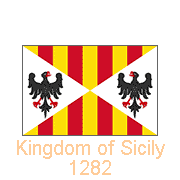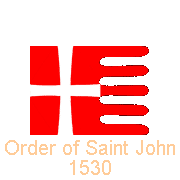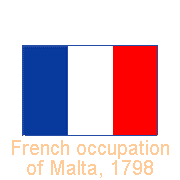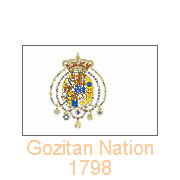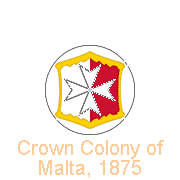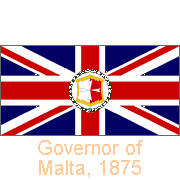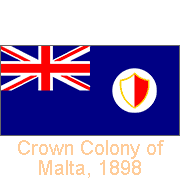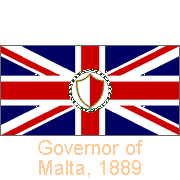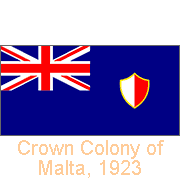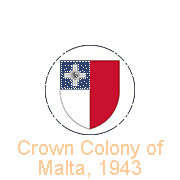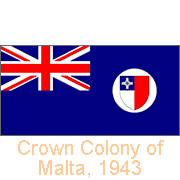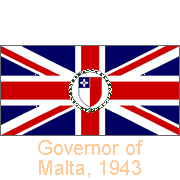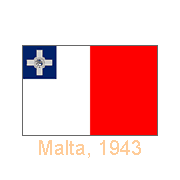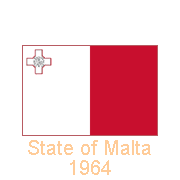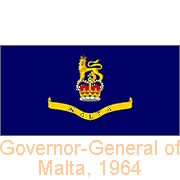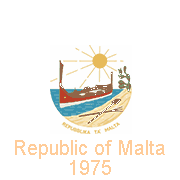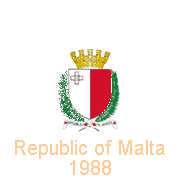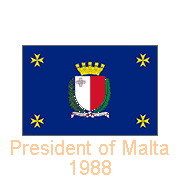Flags from Malta
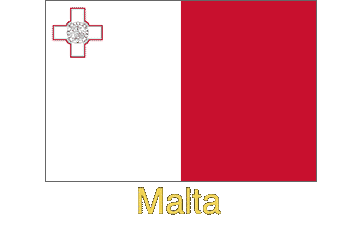
A Flag history of Malta
According to tradition (but this cannot be verified), the white and red colours of the Maltese flag had their origin in the red-and-white checkered flag of the French Norman family of Hauteville. It was the family of Count Roger, who conquered Sicily and, in 1090, Malta, expelling the Arabs. The white and red fields, originally squares, came from the last two squares of the Hauteville Norman flag.
you may then send it as a postcard if you wish.
Malta became part of the Kingdom of Sicily under Roger I and, after being ruled by the Hohenstaufen dynasty and the Capetian House of Anjou, it fell in 1282 to the Crown of Aragon. Its flag, in various forms, included vertical red and yellow stripes (still common on Spanish regional flags) and two black eagles. In 1530 the Holy Roman Emperor, Charles V of Spain, gave the Maltese islands to the Order of Knights of the Hospital of St. John of Jerusalem in perpetual lease. Their flag was red, with a white cross, widening at the ends, throughout, the forerunner of the Maltese Cross. It has been depicted with tails streaming from the fly.
On 11 June 1798, Napoleon Bonaparte and his fleet arrived in Malta on his way to Egypt, demanding entry into the harbour. After soldiers invaded Malta, the knights were forced to surrender, ending their 268-year rule. A French garrison was left on the island, and the French tricolour flag, adopted in 1790 after the French Revolution, was now flown. Soon the Maltese rebelled, and Great Britain and the Kingdoms of Naples and Sicily sent help and ammunition. British navy blockaded the islands, and the French surrendered the island of Gozo on 28 October 1798. The Gozitans, people of Gozo, then declared Ferdinand III of Sicily as their monarch and adopted the flag of the Kingdom of Sicily, white with a shield depicting arms of regions once under Spanish control and Distinguished Orders hanging from chains, all surmounted by a royal crown.
In September 1800, the French garrison in Valletta surrendered, and Malta became a British Protectorate. The British reunited the Maltese islands a year later, and the Union Jack, which had been adopted that year, became Malta’s flag. Malta became a Crown Colony in 1813 and remained it until 1964. In line with other Crown Colonies, it flew the British Blue Ensign with a badge in its fly; it changed slightly over the years but always depicted a white-and-red shield. The Governor’s flag also followed the usual pattern of the British Empire, a Union Flag with the badge on a white disk, surrounded by a laurel wreath, in its centre.
In 1942 King George VI awarded the George Cross to the people of Malta for their heroism during the bombardments. On 28 December 1943, he granted permission for a representation of it to be placed in a blue canton on the red and white shield; this became the new badge, and this duly appeared that year on the Blue Ensign and the Governor’s flag. Throughout the 20th century, people flew an unofficial white-and-red flag, and in 1943 the George Cross in a blue canton was placed on it as well. Queen Elizabeth II approved the white and red flag as an official Civil Flag of Malta in 1954. No formal announcement was made: the Maltese considered it their flag (without the blue canton) for most of the 20th century.
On 21 September 1964, the State of Malta obtained its independence and its new flag hoisted: the traditional red and white flag, with the George Cross in the upper hoist, the blue canton changed to a narrow red fimbriation or fringe. On 13 December 1974, Malta became a Republic without a flag change. A Coat of Arms was adopted, depicting a shield with a heraldic representation of the national flag. It was flanked by two dolphins and surmounted by a knights’ visor and a mural crown, representing the extensive fortifications built at the time of the Knights of Saint John.
On 13 December 1974, Malta became a Republic. A new emblem was adopted seven months later: the Labour Prime Minister, Dom Mintoff, mistook the mural crown representing royalty and wanted it removed. The emblem adopted on 11 July 1975 depicted a coastal scene with a boat and a rising sun. It was designed by art student Edward Abela. However, there was controversy, as it was not a heraldic symbol. After the Nationalists won the 1987 election, the new emblem was adopted the following year: a shield with a heraldic representation of Malta’s national flag, surmounted by a golden mural crown, representing Malta’s fortifications. It is framed by a palm- and an olive branch, representing victory and peace and tied with a white ribbon inscribed, in black capitals, “Repubblika ta’ Malta” (Republic of Malta). That same year a Presidential flag was adopted, depicting the new Coat of Arms on a blue field, with golden Maltese crosses in each corner.


